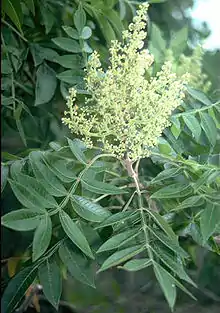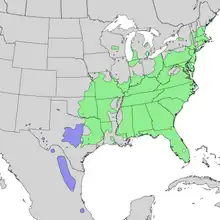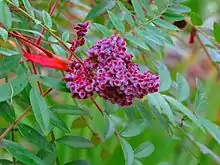Rhus copallinum
Rhus copallinum (Rhus copallina is also used, but this is not consistent with the rules of the International Association for Plant Taxonomy),[3][4] the winged sumac,[5] shining sumac, dwarf sumac or flameleaf sumac, is a species of flowering plant in the cashew family (Anacardiaceae) that is native to eastern North America. It is a deciduous tree growing to 3.5–5.5 metres (11–18 ft) tall and an equal spread with a rounded crown. A 5-year-old sapling will stand about 2.5 metres (8.2 ft).
| Rhus copallinum | |
|---|---|
 | |
| Scientific classification | |
| Kingdom: | Plantae |
| Clade: | Tracheophytes |
| Clade: | Angiosperms |
| Clade: | Eudicots |
| Clade: | Rosids |
| Order: | Sapindales |
| Family: | Anacardiaceae |
| Genus: | Rhus |
| Species: | R. copallinum |
| Binomial name | |
| Rhus copallinum | |
| Varieties | |
|
R. c. var. copallinum | |
 | |
| Native range of Rhus copallinum var. copallinum (green) & var. latifolia (blue) | |
| Synonyms | |
|
Rhus copallina | |
Description



Shining sumac is often cultivated, where it is well-suited to natural and informal landscapes because it has underground runners which spread to provide dense, shrubby cover for birds and wildlife.[6] This species is valued for ornamental planting because of its lustrous dark green foliage which turns a brilliant orange-red in fall. The fall color display is frequently enjoyed along interstate highways, as the plant readily colonizes these and other disturbed sites.[6] The tiny, greenish-yellow flowers, borne in compact, terminal panicles, are followed by showy red clusters of berries which persist into the winter and attract wildlife.
The flowers are yellow, flowering in the summer. The fruit attracts birds with no significant litter problem, is persistent on the tree and showy.
The bark is thin and easily damaged from mechanical impact; branches droop as the tree grows, and will require pruning for vehicular or pedestrian clearance beneath the canopy; routinely grown with, or trainable to be grown with, multiple trunks. The tree wants to grow with several trunks, but can be trained to grow with a single trunk. It has no thorns.
Cultivation and uses
The tree can be planted in a container or above-ground planter. It has been recommended for buffer strips around parking lots or for median strip plantings in the highway, as well as for land reclamation. Rhus copallinum can tolerate exposure to salt spray in maritime forests and coastal grasslands; it can grow in serpentine soil and shallow, rocky soil.[7]
The tree grows in full sun or part shade.[7] Soil tolerances include clay, loam, sand, slightly alkaline, acidic, and well-drained soil. Its drought tolerance is high.[8]
The somewhat sour berrylike fruits are edible and rich in vitamin A.[9] They are eaten by wildlife and can be made into a lemonade-like drink. Additionally, deer browse the twigs of the species.[10] The leaves make up part of the diets of captive Coquerel's sifakas (lemurs).[11]
References
- BGCI. 2017. GlobalTreeSearch online database. Richmond, U.K. Available at: https://www.bgci.org/global_tree_search.php. (Accessed: August 2017).
- "NatureServe Explorer 2.0 - Rhus copallinum, Winged Sumac". explorer.natureserve.org. Retrieved 5 May 2020.
- "CHAPTER III. Nomenclature of taxa according to their rank SECTION 4. Names of species Article 23". International Association for Plant Taxonomy. Retrieved 2014-10-01.
when it is a noun in apposition or a genitive noun, it retains its own gender and termination irrespective of the gender of the generic name.
- Linne (1753). Sp. pl. ed. 1, ed. 2; Syst. nat. ed. 10. doi:10.5962/bhl.title.669.
- USDA, NRCS (n.d.). "Rhus copallinum". The PLANTS Database (plants.usda.gov). Greensboro, North Carolina: National Plant Data Team. Retrieved 21 October 2015.
- John K. Francis (ed.). "Wildland shrubs of the United States and its Territories: thamnic descriptions: volume 1" (PDF). United States Department of Agriculture. p. 625. Retrieved 13 October 2018.
- "Tree and Shrub Descriptions for State Nursery-Raised Seedlings". New York State Department of Environmental Conservation. 7 November 2014. Retrieved 25 October 2020.
- "Rhus copallina Shining Sumac" by Edward F. Gilman and Dennis G. Watson, Forest Service, Department of Agriculture, Fact Sheet ST-568, October 1994
- Niering, William A.; Olmstead, Nancy C. (1985) [1979]. The Audubon Society Field Guide to North American Wildflowers, Eastern Region. Knopf. p. 324. ISBN 0-394-50432-1.
- Little, Elbert L. (1980). The Audubon Society Field Guide to North American Trees: Eastern Region. New York: Knopf. p. 548. ISBN 0-394-50760-6.
- "Annual sumac harvest for sifakas' winter diets". Duke University. 10 September 2018. Retrieved 25 October 2020.

